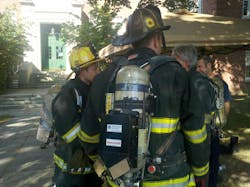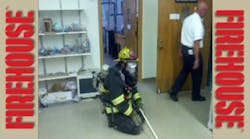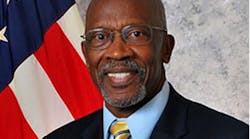While it’s a long way from ready for prime time, new technology designed to track and locate firefighters was successfully tested during the 7th annual Precision Indoor Personnel Location and Tracking workshop at Worcester Polytechnic Institute (WPI), in Worcester, Mass., on Tuesday.
The product is big, heavy and not foolproof – all things that make firefighters suspect – but the concept and the technology work, said the developers from the U.S. Department of Homeland Security and its commercial partners from Honeywell, TRX System and Boeing Argon ST.
“What we have here is a functional prototype,” said Jalal Mapar, program manager for the DHS Infrastructure Protection and Disaster Management Division. “…People kept asking me if I was OK, if I was ready [for the test] and I’ve got to tell you I was about to do you know what in my pants. They wouldn’t tell us what the test was. They wouldn’t tell us which building. But, it works and it works very well.”
Mapar acknowledged there are some glitches, like a slight delay in signal transmission from the firefighter with the equipment to the laptop that displays the wearer's location, plus the size and the durability of the unit. He said he hopes to have a product ready for field testing in six to eight months.
For the past seven years, firefighters from the Worcester Fire Department have volunteered to test the prototypes made available during the workshop that draws attendees and vendors from around the world. This year the DHS’s attempt at solving the problem, called the GLANSER, which stands for Geospatial Location Accountability and Navigation System for Emergency Responders, was put to the test.
Under the command of Worcester Deputy Chief of Operations John Sullivan, about a dozen Worcester firefighters tested the GLANSER system. Sullivan was assisted by Ric Plummer, a retired fire engineer with the Berlin (Mass.) Fire Department who helped with command and logistics of the test. Sullivan later said one of the firefighters testing the system lost his father in the Worcester Cold Storage fire on Dec. 3, 1999.
“I didn’t want to embarrass him while everyone was there, but he was testing a device that he knows in his heart could have helped save his father,” Sullivan said, noting that the firefighter location workshop was established as a direct result of that fire which claimed six Worcester firefighters.
Early Tuesday morning, the firefighters, who were fully outfitted with turnout gear, including SCBAs, converged on Kaven Hall, WPI’s civil and environmental engineering department, for a simulated lab fire. The firefighters conducted two scenarios, both of which had simulated fire in one of the labs.
In the first scenario firefighters were asked to do a primary search of the three-story, ordinary-construction brick campus building, and as the firefighters made their way through the building, Deputy Sullivan said conditions in the building had deteriorated and he was calling for an evacuation. During that evacuation, a simulated ceiling collapse trapped a firefighter, and his partners reported low air and were forced to leave the trapped firefighter behind. Sullivan ordered a Rapid Intervention Team (RIT) into the building to look for the trapped firefighter.
Because the trapped firefighter was wearing a GLANSER device, Sullivan, who was seated at the incident command post, could see his location on a laptop screen. The tracking device had followed him throughout the building and had him stationary on the third floor on the C and D corner of the fire building.
With that information, Sullivan was able to deploy the RIT to the closest entrance and to the sector and floor within minutes.
During the RIT deployment, an antenna on the GLANSER pack was hit and disabled as the RIT was within 10 feet of the down firefighter and the signal was lost. As Sullivan pointed out, the GLANSER sent the RIT to the room and even though a minor malfunction stopped the signal transmission, the firefighter’s normal training took over and a right-hand search of the room quickly put the RIT at the firefighter’s side.
“We have to remember, this is a tool like all of our other tools,” Sullivan said. “You should let it help you make decisions, not override them… Don’t forget the wall behind you because if it fritzes out, you’re screwed.”
During the second scenario, firefighters were once again deployed to search the same building for a fire in the basement. As the firefighters were doing a search, one of the crew members became separated from the other two firefighters who didn’t realize they had become separated until they made the second floor.
Sullivan then gave a report that the stairwell the crew had just made collapsed, separating the firefighters. With two separate GLANSER units in the building, one with a crew of two and the other fitted to the disorientated firefighter, Sullivan was able to reunite the three firefighters using the tracking device.
As developed, the GLANSER transmits information about the firefighter orientation in relation to the building allowing the incident commander or an appointee to help guide firefighters from a building.
While the unit interface only has the footprint of a building based on what is available from Google Maps, it does have a “bread crumb” like tracking line which allows the commander to see where the firefighters have gone and the direction in which they are heading. It also uses a “cocktail” of technology to provide elevation which indicates the floor on which the firefighters are located.
Mapar, the DHS project director, said the challenge of firefighter location is extraordinarily difficult to solve, but he was pleased that the GLANSER worked so well compared to some previous systems.
“You have held our feet to the fire and we appreciate that,” Mapar said, acknowledging that firefighters wanted technology like this years ago.
He also acknowledged there were some issues to resolve with the GLANSER system as tested, including beefing it up for use in the fire service, reducing its size and weight and then testing it in real life situations.
“We have got the technology down, we know it works,” Mapar said. “Now we have to improve upon it.”
Mapar said it appears that technology designed to help locate firefighters has hit a plateau and he asked if those in attendance if they would object if the DHS and his department started working on making improvements to other systems and technologies used by firefighters. Virtually everyone agreed it might be time to move on to other problems, and no one more passionately than Sullivan.
“If you could figure out a way to predict when a firefighter might have a cardiac emergency, you will save more firefighters in a year than you would in 10 (years) with a firefighter tracking system,” Sullivan said, adding that he said that five years ago and he’s been involved in the workshops for all seven years.
With that said, Mapar indicated the scope of next year’s workshop will expand to include other technological advances in the fire service, including Physiological Health Assessment System for Emergency Responders, PHASER for short, which is a companion program to GLANSER.
“Why don’t you work on fixing my damn radio so it works,” Sullivan also quipped, noting that his $99 phone worked better at a fire scene with a MAYDAY situation than his $1,500 two-way radio.









